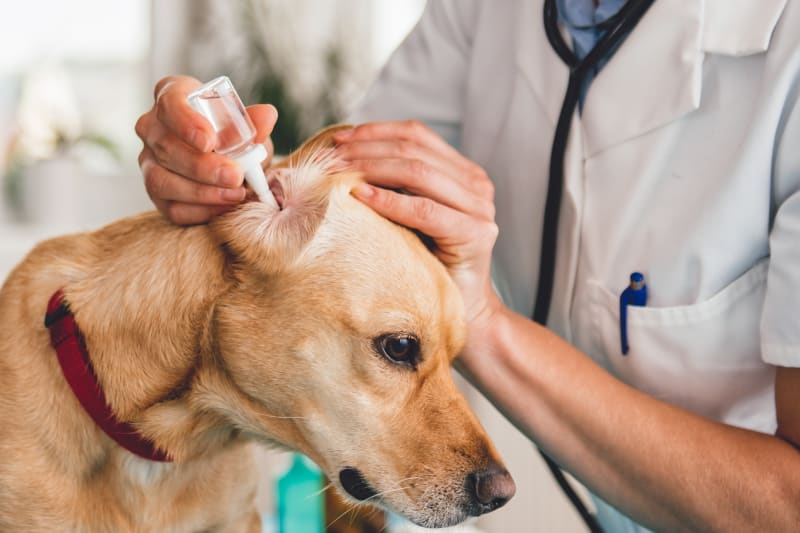Yeast Infection Ear Mites in Dogs? Causes | Symptoms | Treatment
If your dog is scratching their ears, shaking their head, or has a foul-smelling discharge from their ears, they may have an ear problem. Ear problems are common in dogs and may result from different factors, such as bacteria, fungi, parasites, allergies, or trauma. But what is yeast infection ear mites in dogs?
Also Read: Signs of a Dog Ear Infection? Types, Causes & Treatment
Dog Ear Mites vs. Yeast Infection
Ear mites and yeast infections are otitis externa, which means redness of the external ear canal. However, they have different causes and symptoms.
What Are Ear Mites?
Ear mites are small-sized parasites that live on the skin’s surface and feed on ear wax and debris. The most common species of ear mite that affects dogs is `Otodectes cynotis,` which can also infect cats, rabbits, and other animals. Ear mites spread from one animal, like a dog, to another through direct contact or shared bedding.
What Are Ear Infections?
Ear infections result from an overgrowth of bacteria or fungi in the ear canal. The most common type of ear infection in dogs is caused by a yeast called `Malassezia pachydermatis,` which is usually present on the skin in low numbers.
However, when the average balance of the ear environment is disrupted by factors such as moisture, allergies, or injury, the yeast can multiply and cause inflammation and irritation.
Canine Mites Contagious
Ear mites are very contagious among dogs and other animals. If your dog has ear mites, they can easily pass them on to other pets or dogs they come in contact with. Therefore, it is essential to treat all your pets for ear mites at the same time.
Also Read: Is Catnip Safe for Dogs? Effects & Benefits
What Causes Yeast Infections in Dogs?

Yeast infections in dogs are usually secondary to another underlying problem that weakens the skin’s natural defenses.
Some of the common causes of yeast infections in dogs include:
- Food allergies or sensitivities
- Environmental allergies or irritants
- Hormonal imbalances or disorders
- Immune system suppression or diseases
- Antibiotic use or overuse
- Poor hygiene or grooming
What Are the Symptoms of Yeast Infections in Dogs?
Yeast infections can affect different parts of a dog’s body, such as the skin, paws, ears, or genitals. Depending on the location and severity of the infection, some of the symptoms may include:
Skin
- Redness, irritation, or inflammation
- Itching, scratching, or licking
- Greasy or flaky coat
- Hair loss or bald patches
- A foul or musty odor
- Thickened or discolored skin
Paws
- Redness, irritation, or inflammation between the toes or pads
- Itching, licking, or chewing
- Brown discharge or staining around the nails
- Swelling or pain
Ears
- Redness, irritation, or inflammation inside the ear canal or on the ear flap
- Itching, shaking, or rubbing
- Brown or yellow discharge or crusts
- A foul or musty odor
- Hearing loss or balance problems
Also Read: Can Dogs Eat Potatoes?
What’s the Difference Between Ear Mites and Yeast Infections in Dogs?
Ear mites and yeast infections can cause similar symptoms in dogs’ ears, such as itching, discharge, and odor.
However, some distinctive characteristics can help you tell them apart:
- Ear mites produce a dark brown or black granular discharge that resembles coffee grounds. Yeast infections produce a brown or yellow creamy discharge that may have a cheesy consistency.
- Ear mites cause more intense itching than yeast infections. Dogs with ear mites may scratch their ears until they bleed or develop wounds.
- Ear mites are visible under a microscope as white oval-shaped organisms with eight legs. By checking for developing yeast cells in an ear discharge sample under a microscope, it is possible to identify yeast infections.
What’s the Best Dog Yeast Infection Treatment?
The best treatment for yeast infections in dogs depends on the location and severity of the infection.
In general, treatment involves:
Ear
- Cleaning the ear canal with a gentle ear cleaner to remove debris and wax
- Applying a topical antifungal medication to kill the yeast
- Giving oral antifungal medication if the infection is severe or recurrent
- Treating any underlying causes or contributing factors, such as allergies or immune system problems
Skin and Paws
- Bathing the dog with a medicated shampoo that contains antifungal ingredients, such as ketoconazole, miconazole, or chlorhexidine
- Applying a topical antifungal cream or spray to the affected areas
- Giving oral antifungal medication if the infection is widespread or resistant
- Treating any underlying causes or contributing factors, such as allergies or hormonal disorders
Are There Home Remedies for Yeast Infections in Dogs?
Some home remedies that may help with yeast infections in dogs include:
- Apple cider vinegar: After bathing your dog, use water and apple cider vinegar as a rinse or spray. Due to its antifungal and antibacterial qualities, apple cider vinegar may help maintain the skin’s pH balance and stop yeast growth.
- Coconut oil: Apply coconut oil to your dog’s skin or ears. Coconut oil’s antifungal and anti-inflammatory qualities may help calm and heal the skin. You may also feed him coconut oil orally to strengthen your dog’s immune system and combat yeast from within.
- Yogurt: Give your dog plain yogurt that contains live cultures of beneficial bacteria. It can help restore the normal flora of the gut and the skin and prevent yeast overgrowth. To relieve itching and irritation, yogurt can be applied topically to the affected areas.
However, you should consult your veterinarian before using home remedies for yeast infections in dogs. Home remedies may not be enough to treat severe or chronic yeast infections and may interfere with other medications your dog is taking.
Also Read: Why Is My Cat Meowing So Much?
How To Prevent Yeast Infections in Dogs
The ideal way to prevent yeast infections in dogs is to address the underlying causes and maintain good hygiene and grooming.
Some of the preventive measures you can take include:
- Feeding your dog a nutritious but balanced diet that suits their needs and avoids potential allergens or sensitivities
- Keeping your dog’s ears clean and dry and checking them regularly for signs of infection
- Drying your dog’s paws and skin thoroughly after bathing or swimming
- Brushing your dog’s coat regularly to remove dirt and debris and improve air circulation
- Avoiding overuse of antibiotics or steroids that can disrupt the normal flora of the skin and ear
- Strengthening your dog’s immune system with supplements, such as omega-3 fatty acids, probiotics, or antioxidants
Frequently Asked Questions (FAQs)
Does My Dog Have an Ear Infection?
If your dog has any of the following signs, they may have an ear infection:
- Scratching or rubbing their ears
- Shaking their head or tilting it to one side
- Redness, swelling, or discharge in their ears
- The foul or musty odor from their ears
- Pain or sensitivity when touching their ears
- Hearing loss or balance problems
Can Allergies Cause an Ear Infection in Dogs?
Yes, allergies can cause ear infections in dogs. Allergies can make the skin of the ear canal more sensitive and prone to inflammation.
Some of the common allergens that can affect dogs’ ears include:
- Food ingredients, such as chicken, beef, dairy, wheat, corn, soy, or eggs
- Environmental effects, such as dust mites, pollen, mold, grass, or fleas
- Contact irritants, such as shampoo, perfume, detergent, or ear cleaner
Can a Dog Die From an Ear Infection?
Ear infections are usually not life-threatening for dogs if treated promptly and adequately. However, if left untreated, it can lead to severe complications, such as:
- Otitis media is when the infection spreads from the external ear canal to the middle ear, which contains the eardrum and the bones that transmit sound. Otitis media can cause severe pain, hearing loss, facial nerve paralysis, or eardrum rupture.
- Otitis interna is when the infection spreads from the middle ear to the inner ear, which contains the organs that control balance and equilibrium. Otitis interna can cause vertigo, nausea, vomiting, head tilt, nystagmus (involuntary eye movement), or deafness.
- Meningitis is when the infection spreads from the inner ear to the meninges, the membranes covering the brain and spinal cord. Meningitis can cause fever, lethargy, seizures, coma, or death.
Therefore, it is essential to seek veterinary attention as soon as you notice any signs of ear infection in your dog.
Also Read: Can Cats Eat Beans?
Conclusion
Yeast infections and ear mites are two common ear problems in dogs that can cause discomfort and distress. Both conditions can be treated with proper medication and hygiene, but they can also be prevented by addressing the underlying causes and maintaining good ear care.
If you observe any signs of ear infection or ear mites in your dog, you should take them to the veterinarian as soon as possible. You must also keep your dog`s mouth clean as a preventive measure.






